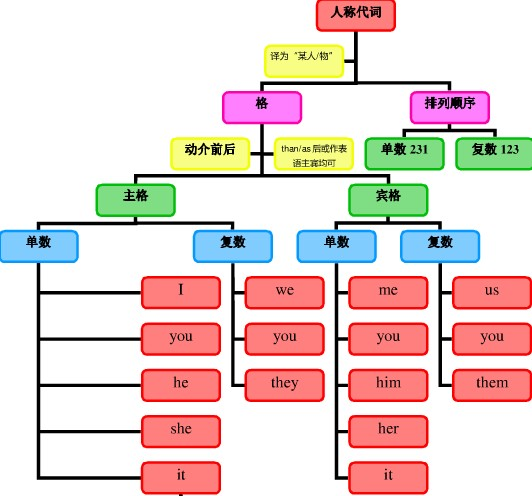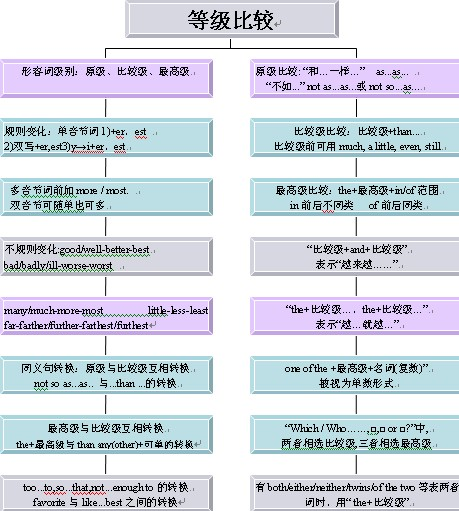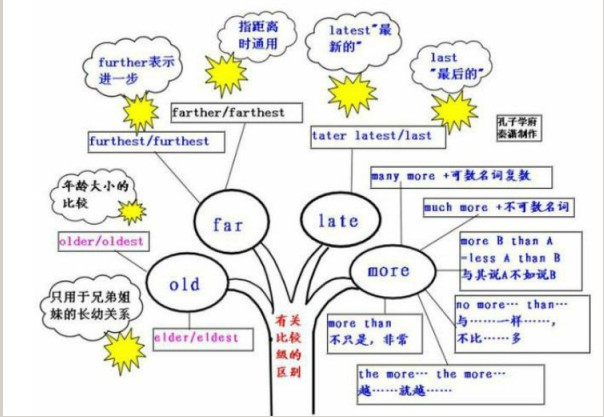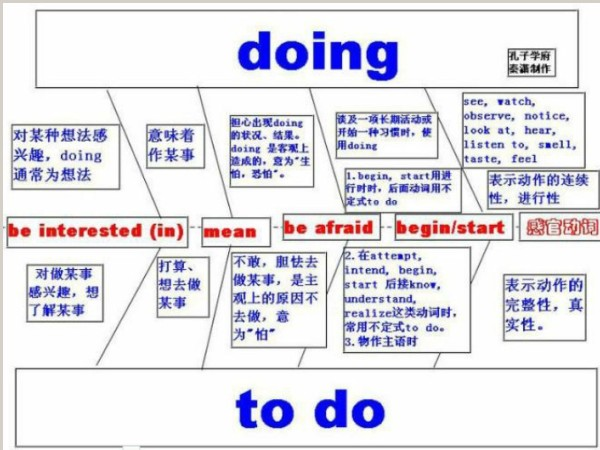本试题 “短文改错。此题要求改正所给短文中的错误。对标有题号的每一行做出判断:如果有错误(每行只有一个错误),则按下列情况改正:此行多一词:把多余的词用斜线...” 主要考查您对不可数名词
不定冠词
人称代词
形容词的比较级
介词和介词短语
并列连词
动词
动名词
等考点的理解。关于这些考点您可以点击下面的选项卡查看详细档案。
- 不可数名词
- 不定冠词
- 人称代词
- 形容词的比较级
- 介词和介词短语
- 并列连词
- 动词
- 动名词
不可数名词的概念:
不可数名词是指不能以数目来计算,不可以分成个体的概念、状态、品质、感情或表示物质材料的东西;它一般没有复数形式,只有单数形式,它的前面不能用不定冠词a / an ,若要表示它的个体意义 时,一般要与一个名词短语连用。
例如: a cup of tea 一杯茶
a piece of news 一则新闻
two pieces of paper 两张纸
不可数名词量的表示:
1)物质名词:
a. 当物质名词转化为个体名词时。
比较:Cake is a kind of food. 蛋糕是一种食物。(不可数)
These cakes are sweet. 这些蛋糕很好吃。(可数)
b. 当物质名词表示该物质的种类时,名词可数。
Thisfactoryproducessteel.(不可数)
如:We need various steels. (可数)
c. 当物质名词表示份数时,可数。
如:Our country is famous for tea. 我国因茶叶而闻名。
Two teas, please. 请来两杯茶。
2)抽象名词有时也可数。
如:four freedoms 四大自由
the four modernizations 四个现代化
注:物质名词和抽象名词可以借助单位词表一定的数量。
如:a glass of water 一杯水
a piece o fadvice 一条建议
不可数名词用法:
1、不可数名词前不能直接加数词或a(an)。切忌犯以下错误: meat, two tea, 应说a piece of meat, two cups oftea。
2、不可数名词无单复数变化,谓语动词一般用单数形式。
如:There is some milk in the glass. 杯里有一些牛奶。
Some food on the table goes bad. 桌子上的食物变质了。
3、能修饰不可数名词的词有:much, a little, little, a bit, some, any, a lot of, plenty of等,以此来表示不确定的数量。如:
much bread 许多面包
a little milk 一点牛奶
a lot of work 许多工作
4、表示具体的数量时应用单位词加of结构。
如:I bought two kilos of meat. 我买了两公斤肉。
He ate three pieces of bread. 他吃了三块面包。
Would you like a cup of coffee? 你想喝杯咖啡吗?
不定冠词的概念:
冠词是置于名词前,说明各词所表示的人或事物的一种虚词,它不能离开名词而单独存在。冠词有两种,一种是定冠词,一种是不定冠词。定冠词是the,不定冠词有两种形式,一是a,另一是an。不定冠词a用于辅音音素起首的单词前,an用于元音音素起首的单词前。如:a bike, a dog, an egg, an elephant
不定冠词的特殊用法:
(1)用于序数词之前,表示数量或序数的增加:
如:Soon I saw a second plane.不久我又看到了另一架飞机。
"This is the second time that I've read the book." “这是我第二次看这本书。”
"Do you want to read it a third time?"“你还想看第三次吗?”
(2)用于表示“非常”、“很”等意义的most前:
如:This is a most interesting story. 这是一个非常有趣的故事。
(3)用于物质名词前,使之转化为具体名词,表示“一种”、“一杯之量”等:
如:A coffee, please. 请给我来杯咖啡。
I'd like a tea, please. 我要来杯茶。
(4)用于抽象名词前,使之具体化,表示与该之相关的具体的人或事:
如:He was a success in business. 他事业成功。
It's a pleasure to talk with you. 同你谈话是件令人愉快的事。
(5)用于指人的专有名词前,指某人、某人的作品或艺术品、…似(式)的人等:
如:A Mr Smith wants to see you. 一位名叫史密斯先生的人想见你。
He bought a complete Lu Hsun. 他买了一套鲁迅全集。
He thought he was a Zhu Geliang. 他自以为是诸葛亮。
(6)用于某些由动词转化来或具有动作意味的名词前,表示一次、一番等义(通常与have,take,make,give等动词连用):
如:Let's go out for a walk. 我们出去走走吧。
如:Do you care for as moke? 抽烟吗?
Would you like a drink? 要喝一杯吗?
(7)有的不可数名词或本来带有定冠词the的名词,由于受定语的修饰,其前可用不定冠词,表示某种状态。此时的不定冠词含有类似akindof的意思:
如:have breakfast 吃早餐─have a quick breakfast 吃快餐
the world 世界─a world like ours 像我们这样的世界
(8)构成短语表示数量:
如:a few apples 几个苹果
a little money 一点点钱
a lot of time 许多时间
a great many friends 许多朋友
不定冠词与one的用法解析:
1、两者均可表示“一”的意思,有时可互换。
如:About a[one] thousand students attended the meeting. 大约有1000学生参加了会议。
注:在数字开头时,两者均可用;但若不是数字开头,则应用one,如不可说three thousand a hundred,而说three thousand one hundred
如:A [One]Mr Smith wants to see you. 一个名叫史密斯先生的人想见你。(a Mr...与one Mr...同义,也可说a certain Mr...,但如果没有Mr这样的词,两者则不宜随便互换,否则含意会发生变化。
2、尽管两者均可表示“一”,有时也可换用,但毕竟由于两者的词性不同,用法不同,在多数情况下是不能互换的:
(1)从词性上看:a(an)是不定冠词,主要表示类别,即着重表示其后的名词是某物,而不是其他物;而one表示“一(个)”时是数词,主要表示数量,即强调在数量上是一个,而不是两个或多个。
比较:Give me a dictionary. 给我一本字典。
Give me one dictionary. 给我一本字典。
前者强调的是,我要的是一本字典,而不是一本教材,也不是一本小说等;而后者强调的是,我要的是一本字典,而不是两本字典或多本字典)。
再比较以下一组表达在意义上的区别:
more than a year一年多 (如一年零三个月等)
more than one year 不止一年 (如两年或三年等)
(2)由于one是数词,着重数量意义,所以当要强调数量、进行数量对比或回答how many的提问时,均应用one,而不能用a(an)。
如:He has only one pen, but I have two. 他只有一枝钢笔,但我有两枝。
I want one box, not five. 我想要一个盒子,不是要五个。
—How many friends do you have here? 你在这儿有多少个朋友?
—Only one. 只有一个。
(3)在某些表达中,两者均可用,但含义不同:at a time 每次,同时 at one time 一度,曾经 as a man 就一个人的性格而论 as one man一起,同时,全体一致地
在某些表达中,两者均可用,虽含义相同,但表达不同:
on a hot summe rafternoon 一个炎热的夏日的下午(注意用介词on)
one hot summer afternoon 一个炎热的夏日的下午(注意不用介词on)
an hour and a half一个半小时(通常不说one hour and a half)
one and a half hours 一个半小时
a minute or two一两分钟(通常不说one minute or two)
one or two minutes 一两分种
在绝大多数习语中,两者是不能换用的。如:
in a hurry 匆忙 once up on a time 从前 as a result 结果 all of a sudden突然 oneday 一天
one by one一个一个地 one and all 全部,每个人 one and the same 完全相同的
英语不定冠词(a/an)的用法:
1、用a还是an:一般说来,辅音或半元音[j, w]开头的词要前用a。
如:He has a computer (watch). 他有一台电脑(一块手表)。
He's a university student (European). 他是大学生(欧洲人)。
元音开头的词前要用an。
如:This is an egg (hones tboy). 这是一只鸡蛋(诚实的男孩)。
注意:有的字母(如a,e,f,h,i等) 或缩略词,若第一个音是元音也应用an。
如:He missed an "n" in the word. 他写的这个单词漏了一个n。
2、不要从汉语习惯出发,漏掉必用的a/an。
如:他父亲是著名诗人。
误:His father is famous poet.
正:His father is a famous poet.
3、用于转化为普通名词的专有名词前,表示某某人或某某人的一部作品、艺术品等。
如:A Mr Smith wants to see you. 一位叫史密斯先生的人想见你。
He bought a complete Lu Hsun. 他买了一套鲁迅全集。
4、用于转化为普通名词的物质名词前,表示相应的产品或种类,有时表示数量关系。
如:It’sagoodwine.这是(一种)好酒。 Twocoffeesandatea,please.请来两杯咖啡和一杯茶。
5、用于具体化的抽象名词前,表示与该抽象名词意义相关的人或事等。
如:The party was a great success. 晚会开得非常成功。
It's a pleasure to talk with you. 同你谈话是件愉快的事。
6、用于某些由动词转化来或具有动作意味的名词前,表示一次、一番等意义。
如:Let me have a look. 让我看看吧。
I'll give the car a good wash. 我要把车好好洗一洗。
7、用于序数词前表示数量或序数的增加。
如:He bought a second computer. 他又买了一台(即第二台)电脑。
Later she borne a third son. 后来她又生了第三个儿子。
8、有的不可数名词或本来应该带定冠词(the)的名词,由于受定语(尤其是形容词)的修饰,其前一般要用不定冠词或改用不定冠词,表示某种状态,此时的不定冠词通常含有a kind of的意思。
如:have breakfast 吃早餐→have a quick breakfast 吃快餐
the world 世界→a world like ours 像我们这样的世界
注:有些不可数名词即使受形容词的修饰也不能用不定冠词,容易弄错的有:news(消息),advice(忠告),luck(运气),fortune(运气),work(工作),fun(娱乐,有趣的事),weather(天气),homework(家庭作业),housework(家务活),information(情报),behavior(行为),harm(伤害),damage(损害),progress(进步),furniture(家具),baggage(行李),luggage(行李),poetry(诗),scenery(风景)等。
9、两个单数可数名词连用表示一个整体时,只用一个不定冠词。
如:He is a teacher and poet. 他既是老师又是诗人。
There's a horse and cart on the road. 路上有一辆马车。
10、不定冠词可用来表示“类属”,这是其基本用法,它表明的是某一类属中的每一个人和东西都能说明该类属的整体情况(有类似汉语的“举一反三”或“以此类推”的含义)。此时也可用定冠词或名词复数形式来表示。
如:马是有用的动物。
正:A horse is a useful animal.
正:The horse is a useful animal.
正:Horses are useful animals.
若不是说明每一个人和东西的情况,而是说整个类属,则不能用不定冠词,而要用定冠词。
如:The tiger is indanger of becoming extinct.老虎面临绝种的危险。
Alexander Graham Bell invented the telephone in 1876.亚历山大·格雷汉母·贝尔于1876年发明了电话。
不定冠词知识体系:
| 不定冠词 | a | 1、辅音音素开头的单词前用a,否则用an。 2、泛指,表“一个”但概念比one弱。 3、表类别 a+可数名词单数,不译为“一”。 4、表示单位,相当于“每”的意思。 5、用于序数词前,表“又一,再一”。 6、用于某些固定词组中,a lot of等。 |
| an |
使用不定冠词和不用不定冠词的差异:
1、英语中的某些名词即可用作不可数名词,又可用作可数名词,但是含义不同,用法也不一样。
如:iron 铁;an iron 一个熨斗
kindness 和善; a kindness 一件善事
2、“with+抽象名词”使用时相当于副词,抽象名词前不用不定冠词。
如:with pleasure 乐意地
with kindness 亲切地
with joy 高兴地
with diffculty 吃力地
with angry 生气地
但在“with+a+名词”结构中虽有不定冠词,却没有实际意义。
如:with a smile 微笑地
with an effort 努力地
with a light heart 愉快地
因汉语习惯用错不定冠词的几种情形:
(1)单数可数名词若泛指,其前需加a/an,不要按汉语习惯漏掉此不定冠词:
如:他是著名影星。
正:Heisafamousfilmstar.
误:Heisfamousfilmstar.
(2)不定冠词不能与指示代词、物主代词、所有格等连用:
如:我在公园遇到了我的一位朋友。
正:Imetafriendofmineinthepark.
误:Imetmyafriendinthepark.
(3)不要受汉语影响而用错不定冠词位置:
如:我从未读过如此有趣的书。
正:Ihaveneverreadsuchaninterestingbook.
误:Ihaveneverreadasuchinterestingbook.
误:Ihaveneverreadasointerestingbook.
不定冠词的省略与重复:
(1)在不引起误会的情况下,两个并列名词中的后一个名词前的不定冠词可以省略:
如:The noun is the name of a person or thing. 名词是人和物的名称。
(2)当两个并列名词指的是同一个人时,后一名词前的不定冠词通常省略:
如:His father is a teacher and poet. 他父亲是位教师兼诗人。
但如果要强调这两种身份,也可后一个不定冠词:
His father is a teacher and a poet. 他父亲既是教师,又是诗人。
有时,由于两个并列的名词关系比较紧密、被视为一个整体,也可只用一个冠词:
A man and woman are walking arm-in-arm.一对男女手挽着手走着。
(3)两个形容词并列同时修饰一个名词时,若该名词指的是两个事物,则通常应分别使用两个冠词:
如:We have a black and a white cat. 我们养了一只黑猫和一只白猫。
(比较:We have a black and white cat. 我们养了一只黑白花猫。)
但是,有时两个并列的名词只一个事物,为了加强语气,也有了两个冠词:
如:It was a cold and a dark night. 那是一个又冷又黑的夜晚。
(4)有些由两样东西构成的“自然成对”使用的事物,通常只在其前使用一个冠词:
如:a knife and fork一副刀叉
a cup and saucer 一副茶杯与茶托
a horse and cart 一辆马车
a needle and thread 一根带线的针
hire a car and driver 租一辆配有司机的汽车
有时连第一个冠词也省略(尤其是与介词连用时):
如:with knife and fork 用刀叉
(5)当要对两个并列的名词进行选择和比较方面的强调时,通常应重复两个冠词:
如:Give me a pen, not a pencil. 给我一支钢笔,不是铅笔。
Do you want a novel or a dictionary? 你是想要本小说,还是想要本字典?
人称代词的概念:
人称代词是替代我、你、他、她、它、我们、你们、他们、她们、它们等人称的词。
人称代词分为主格和宾格形式,并有人称的单复数形式。按所替代人称的不同分为第一人称、第二人称和第三人称。
人称代词的用法:
人称代词在句中可以用作主语(用主格,如:I,you,he,she,we,they,等)和宾语(用宾格,如 me,you,him,her,us,them等)
如:He loves her, but she hates him. 他爱她,但她却讨厌他。
注:(1)在口语中,当人称代词用作表语、用于than, as之后或用于强调句中被强调时,可以用语。 例如:
"Who is it?" "It's me."“是谁呀?”“是我。”
He sings better than me. 他比我唱得好。
He is as tall as her. 他和她一样高。
It's me who did it. 这是我干的。但是,若than,as后的人称代词后跟有动词,则必须用主格。例如:
He sings better than I do./ He is as tall as she is.
(2)单独使用的人称代词通常用宾格。
"I' m tired.""Me too."“我累了。”“我也累了。”
"Who wants this?" "Me."“谁要这个?”“我要。”
(3)有时用主格或宾格会导致意思的变化。
I like you better than he. 我比他更喜欢你。为 I like you better than he likes you. 之略。
I like you better than him. 我喜欢你胜过喜欢他。为 I like you better than he likes him. 之略。
人称代词主格、宾格、人称、单复数对比:
|
人称代词 |
单数 |
复数 | ||
|
主格 |
宾格 |
主格 |
宾格 | |
|
第一人称 |
I |
me |
we |
us |
|
第二人称 |
you |
you |
you |
you |
|
第三人称 |
he |
him |
they |
them |
|
she |
her |
them | ||
|
it |
it | |||
人称代词的排序:
人称代词的排列顺序为:单数人称代词通常按“二三一”排列,即you, he and I;复数人称代词通常按“一二三”排列,即we, you and they:
You, he and I are of the same age. 你,他和我都是同一年龄。
We, you and they are all good citizens. 我们,你们和他们都是好公民。
但若是用于承担责任或错误等场合,则可把第一人称I置于其他人称代词之前:
I and Tom are to blame. 我和汤姆该受批评。
比较:Tom and I hope to go there. 汤姆和我想去那儿。
注意:you and I 是固定结构,语序通常不宜颠倒。
人称代词知识体系:

人称代词用法拓展:
1、在通常情况下,人称代词在句子中出现在它所代替的名词之后,即先出现名词,再出现相应的代词。但是,在书面语中,有时也可出现代词,后出现代词所代替的名词。
As soon as it had hopped off, the plane picked up speed.飞机刚一起飞,就加了速。
(比较:As soon as the plane had hopped off, it picked up speed.)
2、人称代词后跟名词同位语。有些人称代词后有时可跟同位语。
These small desks are forus students.这些小课桌是给我们学生的。
We girls often go to the movies together.我们女孩子常一起去看电影。
He asked you boys to be quiet.他要你们男孩子安静些。
形容词比较级概念:
大多数形容词(性质形容词)有比较级,用来表示两个人或事物之间的比较“较……”。
如:I am taller than you.
形容词比较级特殊用法:
1、没有比较对象的比较结构:
所谓没有比较对象的比较结构不是指省略而言,而是指并非真正的比较。
例如:The car runs faster than110 miles. 那辆车时速为110多英里。
There is more than one solution to the problem. 这个问题的解决办法不止一个。
The daily cost in an average hospital in the United States can run as high as $250. 在美国普通医院的每天的费用可高达250美元。
2、用比较级的形式表达最高级的意思:
在这种情况下,往往是将一个人或是一件事与其他所有的人或事相比较。注意别忘了常在比较状语中用any, other, else类的字眼,以将比较主体排除在比较对象以外,因为自己不可以与自己相比较。
例如:He is taller than any one else in our class. 他在我们班比其他任何都高。
Iron is more useful than any other metals. 铁比其他任何金属更有作用。
3、no+比较级+than的结构表示“A和B一样不……”:
例如:She runs no faster than her sister.她与她妹妹一样跑不快。
Tom is no wiser than John. 汤姆和约翰一样没有聪明才智。
He is no richer than his brother. 他与他弟弟一样不富有。
4、汉语可以说“昆明的气候比兰州好”。英语必须加that:
例如:The climate of Kunming is better than that of Lanzhou.
5、英语比较级常译作“较…”、“…一些”等,但不等于汉语的“更…”。汉语的“更…”须用“still”或“even”来表示:
如:This book is even more difficult than that one. 这本书比那本书更难。
6、有些情况下,汉语不用“较”等字眼,英语则须用比较级:
如:Will the younger people give their seats to old people? 请年轻人把座位让给老年人好不好?
形容词比较级的用法:
1、比较级用于二者的比较,其结构是:含有形容词比较级的主句+从属连词than引导的从句(从句中常省去意义上和主句相同的部分)。
如:Li is older than Zhou. 李比周年纪大。(从句中省去了is old)
There are more children in this nursey than in that one. 这个托儿所的孩子比那个托儿所多。(从句中省去了there are children)
After two years' physical training, she is healthier and stronger. 经过两年的体力锻炼,她(比以前)健康强壮多了。(注意这里省去了从句than she was)
We are much better off than ever before. 我们的生活比过去任何时候都要好得多。(than后省去了we were)
Paul weighs less than harry. 保尔的体重比哈利轻。
Mary is less clever than Jane. 玛丽不如简那么聪明。
2、可修饰比较级的词:
1)a bit, a little, rather, much, far, by far, many, a lot, lots, a great deal, any, still, even等
2)还可以用表示倍数的词或度量名词作修饰语。
3)以上词(除by far)外,必须置于比较级形容词或副词的前面。
典型例题:
1)—Are you feeling ____?
—Yes,I'm fine now.
A. any well
B. any better
C. quite good
D. quite better
答案:B. any可修饰比较级,quite修饰原级,well的比较级为better.
2)The experiment was____easier than we had expected.
A. more
B. muchmore
C. much
D. moremuch
答案:C. much可修饰比较级,因此B,C都说得通,但easier本身已是比较级,不需more,因此C为正确答案。
3)If there were no examinations, we should have___at school.
A. the happiest time
B. a more happier time
C. much happiest time
D. a much happier time
答案:D.
注:many, old和far用法:
1)如果后接名词时,much more+不可数名词 many more+可数名词复数
2)old有两种比较级和最高级形式:older/oldest和elder/eldest。elder,eldest只用于兄弟姐妹的长幼关系。
如:My elder brother is an engineer.
3)far有两种比较级,farther,further在英语中两者都可指距离。在美语中,father表示距离,further表示进一步。
如:I have nothing further to say.
3、比较级中的两个特殊作用的结构:
1)The+比较级+句子,表示的意义是“越(怎么样就)越(怎么样)”,在这个结构中的两个“比较级”不要求一定词性相同,它们各自的词性要依句子的需要而定;
2)和比较级+and+比较级。表示的意义是“越来越(怎么样)”,在这个结构中的两个“比较级”则要求词性相同。
例如:The harder you work at your study, the better academicrecords you will have. 你学习越努力,你的成绩就越好。
The more we have, the more we want. 人欲无穷。
When winter is coming, it gets colder and colder. 冬天来临之际,天越来越冷了。
He became less and less satisfied with the foot ball team's performance. 他对足球队的表现越来越不满意了。
形容词比较等级知识体系:

特殊形容词比较级变化:

介词和介词短语的概念:
介词是一种用来表示词与词、词与句之间的关系的虚词,在句中不能单独作句子成分。介词后面一般有名词、代词或相当于名词的其他词类,短语或从句作它的宾语。介词和它的宾语构成介词词组,在句中作状语,表语,补语或介词宾语。介词可以分为时间介词、地点介词、方式介词和其他介词。
误用介词的三种情况:
1、多用介词:
多用介词可能是受汉语意思的影响将及物动词误用作不及物动词,也可能是受相关结构的影响而用错:
误:We discussed about the plan.
正:We discussed the plan. 我们讨论了计划。
误:Did he mention about the accident?
正:Did he mention the accident? 他提到那次事故了吗?
误:I saw her enter into the bank.
正:I saw her enter the bank. 我看见她进了银行。
误:He married with[to] a nurse.
正:He married a nurse. 他同一位护士结了婚。
误:How can contact with you?
正:How can contact you? 我怎么与你联系?
误:We should serve for the people heart and soul.
正:We should serve the people heart and soul. 我们应该全心全意地为人民服务。
误:Who controls over the factory? (但名词control可接over)
正:Who controls the factory? 谁管理这个工厂?
误:He has a great many of friends here. (比较a great number of)
正:He has a great many friends here. 他在这儿有很多朋友。
2、漏用介词:
漏用介词可能是受汉语意思的影响将不及物动词误用作及物动词,或是受相关结构的影响的影响而用错等:
误:This matter is difficult to deal. (deal with=处理)
正:This matter is difficult to deal with. 这事很难处理。
误:He is not a man to be depended.
正:He is not a man to be depended on. 他不是个可靠的人。
误:He took a cup of tea, and went on the story.
正:He took a cup of tea, and wentonwiththestory.他喝了一口茶,又接着讲故事。
误:My mother still regards me a child. (比较consider…as中的as可省略)
正:My mother still regards me as a child. 我母亲还把我当小孩看。
误:They insisted sending a car over to fetch us.
正:They insisted on sending a car over to fetch us.他们坚持要派车来接我们。
误:What he says is worth listening.
正:What he said is worth listening to.他的话值得一听。
3、错用介词:
错用介词的情况比较复杂,可能是因受汉语意思的而错,也可能是因弄不清搭配关系而错,可能是混淆用法而错,也可能是受相关结构的影响而错,可能是忽略语境而错,也可能是想当然的用错:
误:She called on his office yesterday. (call on+人,call at+地点)
正:She called at his office yesterday. 她昨天去了他办公室拜访。
误:He is engaged with a nurse.
正:He is engaged to a nurse.他与一位护士订了婚。
误:The sun rises from the east.
正:The sun rises in the east.太阳从东方升起。
误:Under his help, I finished it in time.
正:With his help, I finished it in time. 在他的帮助下,我及时做完了。
误:During he was in Japan, he visited many places.
正:During his stay in Japan, he visited many places.他在日本期间,参观过许多地方。
误:We are familiar to his character.
正:We are familiar with his character.我们了解他的性格。
误:Help yourself with the fruit.
正:Help yourself to the fruit.吃点水果吧。
介词的宾语:
1、名词或代词作介词宾语:
如:Are you interested in history? 你对历史感兴趣吗?
Don't worry about it. 别为它担心。
注:若是人称代词用作介词宾语,要注意用宾格。
如:No one can sing like her. 没有人能像她那样唱歌。(不能用like she)
2、动名词作介词宾语:
如:He is good at telling stories. 他善于讲故事。
In crossing the street he was run over. 他在穿过马路时被汽车撞倒。
3、过去分词作介词宾语:
如:We can't regard the matter as settled. 我们不能认为这事已经解决。
I take it for granted you have read the book. 我以为你读过这本书。
注:过去分词用作介词宾语通常只见于某些固定结构中,如上面第1句涉及regard…as(认为…是)结构,第2句涉及take sth for granted(认为某事属实)。在其他情况下,介词后通常不直接跟过去分词作宾语,若语义上需要接过去分词(表被动),可换用“being+过去分词”:
如:He went out without being seen by the others.他出去了,没有被其他人看见。
4、从句作介词宾语:
如:He was not satisfied with what she said. 他对她说的不满意。
I'm worried about where he is. 我担心他上哪儿去了。
注:介词后通常不接that从句,遇此情况需考虑用其他结构:
误:He paid no attention to that she was poor.
正:He paid no attention to the fact that she was poor. 他根本不注意她很穷这一事实。
但有个别介词(如except)可接that从句。
比较:I know nothing about him except that he lives next door./I know nothing about him except for the fact that he lives next door. 我只知道他住在隔壁,其它的就不知道了。
5、不定式作介词宾语:
如:I had no choice but to wait. 除了等,我没有别的选择。
He wanted nothing but to stay there. 他只想留在那儿。
They did nothing but complain. 他们老是一个劲地抱怨。
He never did anything but watch TV. 除了看电视,他从不干任何事。
注:(1)介词后接不定式的情形通常只见于but, except等极个别个词。该不定式有时带to,有时不带to,其区别是:若其前出现了动词do,其后的不定式通常不带to;
若其前没有出现动词do,则其后的不定式通常带to。
(2)介词后虽然通常不直接跟不定式作宾语,但却可接“连接代词(副词)+不定式”结构:
如:He gave me some advice on how to do it. 对于如何做这事他给我提了些建议。
6、形容词作介词宾语:
如:Her pronunciation is far from perfect. 她的语音远不是完美的。
In short, we must be prepared. 总而言之,我们要有准备。
Things have gone from bad to worse. 事情越来越糟。
注:(1)有些形容词用作介词宾语可视为其前省略了动名词being:
如:He regarded the situationas(being) serious. 他认为形势严重。
His work is far from(being) satisfactory. 他的工作丝毫不令人满意。
(2)有些“介词+形容词”的结构已构成固定搭配:in full全部地,全面地,无省略地; in private私下地,秘密地; in particular特别地;in general一般地,通常地,概括地; in brief 简言之;in short总之,简言之; in vain徒然地,徒劳无益地;for fee免费地,无偿地; for certain肯定地,确切地;for sure肯定地,确切地; for short为了简短,简称;atl arge自由自在地,逍遥法外; by far…得多
7、副词作介词宾语:
如:I can't stay for long. 我不能久呆。
It's too hot in here. 这里面太热了。
I looked every where except there. 除了那儿,我到处都看过了。
8、数词作介词宾语:
如:The city has a population of four million. 这座城市有四百万人口。
He was among the first to arrive. 他是第一批到的。
9、介词短语作介词宾语:
如:Choose a book from among these. 从这些书中选一本吧。
I saw her from across the street. 我从街的对面望见了她。
注:通常可后接介词短语作宾语的介词是from, till, until, since, except, instead of等。
比较:I took it from the bed. 我从床那儿(或床上)拿的。
I took it from under the bed. 我从床下拿的。
10、复合结构用作介词宾语:
如:She had no objection to Mary marrying him. 她不反对玛丽与他结婚。
She came in with a book in her hand. 她手里拿着一本书走了进来。
All the afternoon he worked with the door locked. 整个下午他都锁着门在房里工作。
介词短语的句法功能:
1、表语:
如:He was with a friend. 他和一个朋友在一起。
Health is above wealth. 健康胜过财富。
This knife is for cutting bread. 这把小刀是用于切面包的。
注:有些介词(如because of)引出的短语通常只用作状语,不用作表语:
误:His absence is because of the rain.
正:His absence is due to the rain. 他因雨未来。
但是,若主语是代词(不是名词),becauseof引出的短语可用作表语:
如:It is because of hard work. 那是因为辛苦工作的原因。
2、状语:
如:Don't touch it with your hands. 别用手去摸它。
Did you do this by design or by accident? 你这样做是有意的还是无意的?
3、定语:
如:This is his reply to your letter. 这是他给你的回信。
This is the best way of doing it. 这是做此事最好的方法。
My love for you is deeper than the sea. 我对你的爱比海深。
4、宾语补足语:
如:I found everythingin good condition. 我发现一切正常。
Her illness kept her in bed for a week. 她因生病在床上躺了一星期。
注:用作宾语补足语的介词短语在相应的被动语态中则为主语补足语:
如:He was regarded as a hero. 他被看成是英雄。
5、宾语:
如:A man stepped out from behind the wall. 一个人从墙后走出来。
He cannot spare anytime except on Sunday. 除星期日外,他抽不出时间。
6、主语:
如:Between6 and 7 suits me. 六点到七点对我比较适合。
After the exams is the time to relax. 考试后是轻松一下的时间。
注:介词短语通常不用作主语,尽管有时也像上面这样用作主语,但通常可视为是在一定的上下文中有所省略:
如:—When are we going to have the next meeting? 我们下次什么时候见面?
—On Tuesday may be convenient. 星期二可能比较方便。
此句中onTuesday虽用作主语,但可视为是其前省略了meeting一词:
即:Meeting during the vacation may be convenient.
并列连词的概念:
连词是一种虚词,它不能独立担任句子成分而只起连接词与词,短语与短语以及句与句的作用。连词主要可分为两类:并列连词和从属连词。并列连词用来连接平行的词、词组和分句。如:and, but, or, nor, so, therefore, yet, however, for, hence, as well as, both...and, notonly...butalso, either...or, neither...nor, (and)then 等等。
并列连词与并列结构:
并列连词引导两个并列的句子。
1)and与or:
判断改错:
(错) They sat down and talk about something.
(错) They started to dance and sang.
(错) I saw two men sitting behind and whisper there.
(对) They sat down and talked about something.
(对) They started to dance and sing.
(对) I saw two men sitting behind and whispering there.
解析:第一句:and连接两个并列的谓语,所以talk应改为talked。
第二句:and连接两个并列的动词不定式,第二个不定式往往省略to,因此sang应改为sing。
第三句:and连接感观动词saw后面的用作的宾补的两个并列分词结构,因此whisper应改为whispering。
注意:and还可以和祈使句或名词词组连用表示条件。(or也有此用法)
如:Make up your mind, and you'll get the chance.=If you make up your mind, you'll get the chance.
One more effort, and you'll succeed.=If you make one more effort, you'll succeed.
2)both...and 两者都
如:She plays(both) the piano and the guitar.
3)not only...but(also), as well as 不但…而且
如:She plays not only the piano, but(also) the guitar.
注意:not only…but also关联两个分句时,一个分句因有否定词not而必须倒装。
如:Not only does he like reading stories, but also he can even write some.
4)neither...nor 意思为“既不……也不……”谓语动词采用就近原则,与nor后的词保持一致。
如:Neither you nor he is to blame.
比较so和such :
so与such的用法由不同词性决定。such是形容词,修饰名词或名词词组,so是副词,只能修饰形容词或副词。so还可与表示数量的形容词many,few,much,little连用,形成固定搭配。
构成:so+adj.
such+a(n)+n.
so+adj.+a(n)+n.
such+n.(pl.)
so+adj.+n.(pl.)
such+n.(pl.)
so+adj.+n.[不可数]
such+n.[不可数]
如:so foolish
such a fool
so nice a flower
such a nice flower
so many/few flowers
such nice flowers
so much/ little money.
such rapid progress
so many people
such a lot of people
注:so many 已成固定搭配,a lot of 虽相当于many,但a lot of为名词性的,只能用such搭配。 so...that与such...that之间的转换既为so与such之间的转换。
并列连词用法点拨:
1、表示并列关系:
1)or意思为“否则”。
如:I must work hard, or I'll fail in the exam.
2)either...or意思为“或者……或者……”。注意谓语动词采用就近原则。
如:Either you or I am right.
2、表示转折或对比关系:
1)but表示转折,while表示对比。
如:Some people love cats, while others hate them.
典型例题:
—Would you like to come to dinner tonight?
—I'd like to, ___ I'm too busy.
A. and
B. so
C. as
D. but
答案:D。but与前面形成转折,符合语意。而表并列的and,结果的so,原因的as都不符合句意。
2)not...but...意思为“不是……而是……” not和but后面的用词要遵循一致原则。
如:They were not the bones of an animal, but(the bones) of a human being.
3、表示原因关系:
1)for 判断改错:
(错)For he is ill, he is absent today.
(对)He is absent today, for he is ill. for是并列连词,不能置于含两个并列分句的句子的句首,只能将其放在两个分句中间。
并列连词知识体系:
| 种类 | 用法 | 举例 |
| 并列连词 | 表示转折关系 | yet, but等 |
| 表示并列关系 | and, or, either...or..., as welll as等 | |
| 表示因果关系 | for, so等 |
比较and和or的用法:
1)并列结构中,or通常用于否定句,and用于肯定句。
2)但有时and也可用于否定句。请注意其不同特点:
如:There is no air or water in the moon.
There is no air and no water on the moon.
在否定中并列结构用or连接,但含有两个否定词的句子实际被看作是肯定结构,因此要用and。
典型例题:
—I don't like chicken___fish.
—I don't like chicken, ___I like fish very much.
A. and;and
B. and;but
C. or;but
D. or;and
答案:C。否定句中表并列用or,but表转折。
判断改错:
(错)We will die without air and water.
(错)We can't live without air or water.
(对)We will die without air or water.
(对)We can't live without air and water.
动词的定义:
表示动作中状态的词叫做动词。根据其在句中的功能,动词可分为行为动词、系动词、助动词和情态动词四类,有些动词是兼类词。
例如:We have lunch at 12. (have是行为动词)
We have been to NewYork. (have是助动词)
I am hungry. (am是系动词)
You need not have waited for me. (need是情态动词)
The door needs painting. (need是兼类词)
动词的分类:
1)表示动作中状态的词叫做动词。
2)根据其在句中的功能,动词可分为四类,分别是:
实义动词(Notional Verb)、系动词(Link Verb)、助动词(Auxiliary Verb)、情态动词(Modal Verb)。
说明:有些情况下,有些动词是兼类词。
例如:We are having a meeting. 我们正在开会。(having是实义动词。)
He has gone to NewYork.他已去纽约。(has是助动词。)
3)动词根据其后是否带有宾语,可分为两类,分别是:
及物动词(Transitive Verb)、不及物动词(Intransitive Verb),缩写形式分别为vt.和vi.。
说明:同一动词有时可用作及物动词,有时可用作不及物动词。
例如:She can dance and sing. 她能唱歌又能跳舞。(sing在此用作不及物动词。)
She can sing many English songs. 她能唱好多首英文歌曲。(sing用作及物动词。)
4)根据是否受主语的人称和数的限制,可分两类,分别是:
限定动词(Finite Verb)、非限定动词(Non-finite Verb)。
例如:She sings very well. 她唱得很好。(sing受主语she的限制,故用第三人称单数形式sings。)
She wants to learn English well. 她想学好英语。(to learn不受主语she的限制,没有词形变化,是非限定动词。
说明:英语中共有三种非限定动词,分别是:动词不定式(Infinitive)、动名词(Gerund)、分词(Participle)。
5)根据动词的组成形式,可分为三类,分别是:
单字词(One-Word Verb)、短语动词(Phrasal Verb)、动词短语(Verbal Phrase)
例如:The English language contains many phrasal verbs and verbal phrases. 英语里有许多短语动词和动词短语。(contains是单字动词。)
Students should learn to look up new words in dictionaries. 学生们学会查字典。(look up是短语动词。)
The young ought to take care of the old. 年轻人应照料老人。(takecareof是动词短语。)
6)动词有五种形态,分别是:
原形(OriginalForm)、第三人称单数形式(Singular From in Third Personal)、过去式(Past Form)、过去分词(Past Participle)、现在分词(Present Participle)。
动词知识体系:

动名词概念:
动名词是一种兼有动词和名词特征的非限定动词。它可以支配宾语,也能被副词修饰,动名词有时态和语态的变化。
现在分词和动名词用法比较:
动词的-ing形式包括现在分词和动名词两种形式。他们的句法功能如下:
动词的-ing形式如果作句子的主语或者宾语时,应该是动名词形式;如果作补语或者状语时,应该是现在分词形式。那么作表语或者定语的动名词和现在分词又该怎样区分呢?
1、动名词与现在分词作表语时的比较:
(1)动名词作表语说明主语的内容,回答what的问题;现在分词作表语相当于形容词作表语,说明主语的性质、特征等,回答how的问题。
如:One of the best exercises is swimming. 游泳是最好的运动项目之一。
What pleases him most is bathing in the sea. 最使他高兴的事是在海中沐浴。
The situation both at home and abroad is very in-spiring. 国内外的形势都很鼓舞人心。
The color is pleasing to the eye. 颜色悦目。
(2)动名词作表语,表语和主语几乎处于同等地位,可以互换位置,其句意不变;现在分词作表语,表语和主语则不能互换位置。
如:Our work is serving the people.
(=Serving the people is our work.)我们的工作是为人民服务。
The news was disappointing. 那消息令人失望。
(3)作表语的现在分词前可以用very,quite,rather,greatly等副词修饰,而动名词则不可以。
如:What he said was very encouraging. 他的话很鼓舞人心。
Our goal is realizing the four modernizations in the near future. 我们的目标是在不久的将来实现四个现代化。
(4)现在分词与形容词一样可以和more,the most构成形容词的比较级和最高级,而动名词则不可以。
如:The story is the most fascinating. 那个故事最迷人。
(5)作表语用的现在分词除了和be连用以外,还可以和其它的系动词连用;而作表语的动名词则通常只能和be连用。
如:His speech seems inspiring.他的演讲似乎很鼓舞人心。
His interest is writing for the news papers. 他的爱好是给报社写文章。
(6)有些用作表语的现在分词已经形容词化了。常见的有:exciting,moving,inspiring,missing,interesting,disappointing等。
2、动名词与现在分词作定语时的比较:
(1)动名词作定语时,表示它所修饰的名词的性能和用途,和它所修饰的名词在逻辑上没有主谓关系;
现在分词作定语时,表示它所修饰的名词正在进行的动作,和它所修饰的名词在逻辑上有主谓关系,常可以扩展成一个定语从句。
如:a swimming girl=a girl who is swimming 一个在游泳的姑娘
a walking stick=a stick that is used for walking 一根拐杖
(2)现在分词作定语有时可以后置,而动名词则通常只能放在它所修饰的名词之前。
如:The girl wearing glasses is one of his students. 戴眼镜的那个女孩是他的一个学生。
I bought some reading materials. 我买了一些阅读材料。
动名词的用法:
1、作主语:
例如:Fighting broke out between the South and the North. 南方与北方开战了。
2、作宾语:
a. 有些动词可以用动名词作宾语。
例如:admit承认 appreciate感激 avoid避免 complete完成 consider认为 delay耽误 deny否认 detest讨厌 endure忍受 enjoy喜欢 escape逃脱 fancy想象 finish完成 imagine想象 mind介意 miss想念 postpone推迟 practice训练 recall回忆 resent讨厌 resume继续 resist抵抗 risk冒险 suggest建议 face面对 include包括 stand忍受 understand理解 forgive宽恕 keep继续
例如:Would you mind turning down your radio a little, please? 你把收音机音量调小一点,好吗?
The squirrel was lucky that it just missed being caught. 这松鼠幸运得很,刚逃避了被逮住的厄运。
b. 有些结构后面可以用动名词作宾语或其他成分。
例如:admit to prefer...to burst out keep on insist on count on set about put off be good at take up give up be successful in be used to lead to devote oneself to object to stick to no good no use be fond of look forward to be proud of be busy can't help be tired of be capable of be afraid of think of
3、作表语,对主语说明、解释:
例如:Her job is washing, cleaning and taking care of the children. 她的工作是洗刷、清扫和照顾孩子。
比较:She is washing, cleaning and taking care of the children.
4、作定语,一般表示所修饰名词事物的用途:
例如:a writing desk=a desk for writing 写字台
a swimming pool=a pool swimming 游泳池
有些动名词作定语,与所修饰的名词关系比较复杂。
例如:boiling point=a temperature point at which something begins to boil 沸点
a walking tractor=a tractor which a driver can operate while he or she is walking behind it 手扶拖拉机
动名词知识体系:

动名词与不定式用法对比:

与“短文改错。此题要求改正所给短文中的错误。对标有题号的每一...”考查相似的试题有:
- It was _______ great shock to the world that two Chinese astronauts orbited Earth for five days in ________ Shenzhou ...
- His camera is more expensive than ___.A.oursB.ourC.usD.we
- David got a higher grade in the final exam, for, you see, he made _____ mistakes.A. fewB. fewerC. littleD. less
- Of the two coats, I’d choose the __________ one to spare some money for a book.A.cheapestB.cheaperC.more expensive...
- (2013·东北育才中学月考) Prices of the houses in Chongqing are quite high, while those in Shenzhen are ________.A.mor...
- The cat padded across the road and towards the bushes just _______ the hornbeam trees, and she stopped.A.except forB...
- The traveler __________ us with his stories,most of which happened in the war and were fullof great adventures.[ ]A...
- Some of the rubbish, such as food, paper and iron, _____ away over a long period of time. A.rotB.rotsC.is rottingD...
- Having been ill in bed for nearly a month,he had a hard time _____ the exam.[ ]A. passB. to passC. passedD. passing
- ____ in a dark room, the little girl was so frightened as to cry loudly.A.Leaving lonelyB.Left aloneC.Being left a...